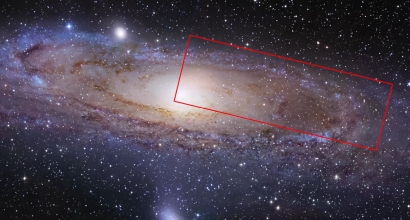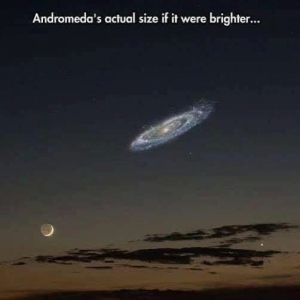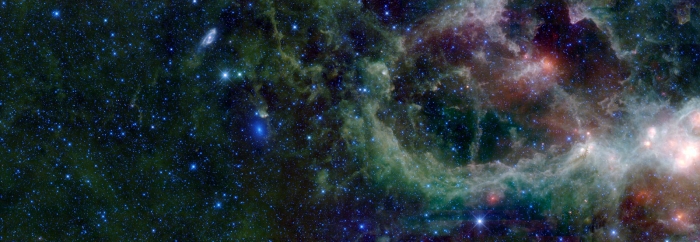  The Andromeda galaxy is the closest large spiral galaxy to our own Milky Way. At a distance of 2.5 million light-years, itís the furthest thing we humans can see with the unaided eye. First photographed in the year 1900, astronomers couldnít discern individual stars in the galaxy. Many thought it was a nebula ... a cloud of gas within our Milky Way, a place where new stars were forming. It wasnít until the 20th century that astronomers were able to resolve the Andromeda spiral nebula into individual stars.  This Hubble telescope image, at 69,536 x 22,230 pixels, is the largest, sharpest image ever taken of the Andromeda Galaxy. It's an absolutely incredible view of this neighbour galaxy, which is made up of about one trillion stars, as compared to our own Milky Way's 300 - 400 million. At a distance of about 2.5 million light years from us, we see these star systems that make up Andromeda the way they were 2.5 million years ago.
This Hubble telescope image, at 69,536 x 22,230 pixels, is the largest, sharpest image ever taken of the Andromeda Galaxy. It's an absolutely incredible view of this neighbour galaxy, which is made up of about one trillion stars, as compared to our own Milky Way's 300 - 400 million. At a distance of about 2.5 million light years from us, we see these star systems that make up Andromeda the way they were 2.5 million years ago.

Astronomers sometimes refer to the Andromeda galaxy by the name Messier 31, or M31. This is because it was the 31st on a famous list of fuzzy sky objects compiled by the French astronomer Charles Messier (1730-1817). His catalog listed 'objects to avoid' when comet-hunting. Most Messier objects are star clusters or gas clouds in our own Milky Way galaxy. But the Andromeda galaxy is a whole separate galaxy, even bigger than our Milky Way. In a dark sky, you can see that itís big in the sky as well, a smudge of distant light larger than a full moon. The Andromeda and Milky Way galaxies are the two most massive galaxies within the Local Group of about 35 galaxies. Both are about 100,000 light-years across. Astronomers have discovered that our Local Group is on the outskirts of a giant cluster of several thousand galaxies, which they call the Virgo Cluster. We also know of an irregular supercluster of galaxies, which contains the Virgo Cluster, which in turn contains our Local Group, which in turn contains our Milky Way galaxy and the nearby Andromeda galaxy. At least 100 galaxy groups and clusters are located within this Virgo Supercluster. Its diameter is thought to be about 110 million light-years.  And the Virgo Supercluster is thought to be one of millions of superclusters in the observable universe. |